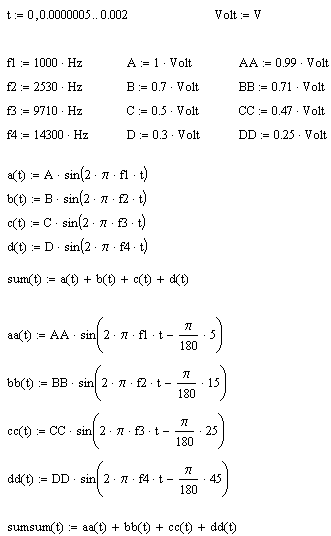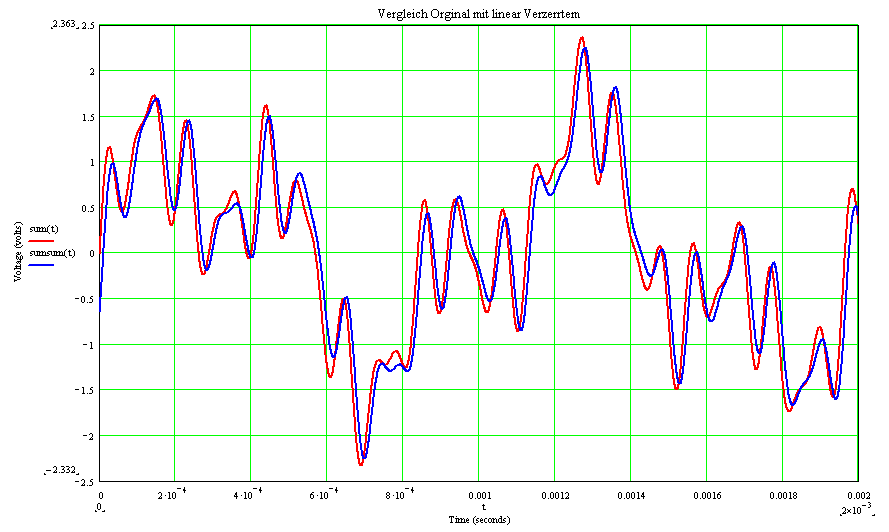Linear DistortionsPhase- and Amplitude errors cause linear distortions Linear distortions do not produce any new frequencies compared to nonlinear distortions. Let me describe in pictures and simple words, without the assistance of the mathematically oriented filter theory, available in literature, which serves however often only for the self-manifestation of the mathematical garbness of the author and which practical meaning often neglects. This literature is often not meaningful for the beginner. ReasonsPhase Failures - each amplifier under a certain frequency requires a signal running time, i.e., passes a finite time, until at the output of the amplifier the signal is available again. This turn-around time is finally, shorter with a fast amplifier naturally than with a slower one. The signal propagation delay time will be with sinusoidal signals indirectly measurably as phase shift, becomes visibly by the representation of input and output signal common on an oscilloscope. With increasing signal frequency the phase shift continues to rise between input and output signal. If a music signal is set on an amplifier, different frequencies amplified with different amplitude errors and phase shifts. The result is a signal, which looks no longer look like the original signal, it is not only amplified (which it should also be), it is also additionally linear distorted. Amplitude error - due to the finite bandwidth of an amplifier, signals in particular higher-frequency signals any more 1 to 1, i.e. an amplitude from e.g.. 1 V is transferred only with 0.98 V. If the signal frequency reached the bandwidth, then only 0.707 V response to 1 V. Different frequencies becoming different amplification factors. The signal from the amplifier is not comparable any longer with the original signal. Linear distortions developed in such a way. Combination from both sources of error - both sources of error are combined. A too low bandwidth of the amplifier causes amplitude and phase errors. For an Audio Amplifier - a sufficiently high bandwidth,for an hifi amplifier of elementary importance. The linear distortions remain so small. Each sound control (bass, treble) produces linear distortions. For example an treble control raises high frequencies and causes thereby a desired amplitude error. Normally a sound controll should be only used, to correct hearing wishes, in this case by inserting linear distortions the entire amplitude response becomes (feeled) again linearized. Note: e.g. a treble control causes a desired amplitude error, in addition, automatically an inadvertent phase error, which falsify again the original signal. Those are fundamental filter characteristics. Naturally there are voices - those maintains the human ear is substantially more sensitive for amplitude errors than for phase errors. My experience confirms this too. However to state phase errors are uninteresting, that are also not o.k. Is often tried to define a low bandwidth of a Hifi amplifier as less important and to play the importance down of the amplifiers bandwidth. When phase errors become audible, I cannot discuss, since I did not undertake detailed attempts themselves ever and also do not need. A loudspeaker manufacturer has herein very much more experience with "whether" "when" and "how" linear distortions become audible. With its crossover networks, housings, rooms and loudspeakers he must concern himself very much with phase relationships and their effects. Honestly - "whether" "when" and "how" it is for me less of importance, I tries these linear distortions by good circuits to avoid from the beginning. Distortions behind a rhetorical curtain to hide is not the fine kind. It is an incontestable fact, linear distortions is from electrotechnical view a clear error, which it applies to avoid. Make Linear Distortions visibleOn the basis a descriptive simple mathematical simulation the occurrence of linear distortions is to be demonstrated. In addition signal frequencies, amplitudes and phase errors were accepted. It proceeded from an amplifier, which has a bandwidth of approximately only 15 kHz. An amplification factor of "unity" simplifies the simulation. |
|
|
|
Figure 1 (equations left side) Simulation from time zero to 2 milliseconds Signalfrequencies f1 to f4. Original signal amplitudes A to D. Real amplitudes with amplitude errors AA to DD. The original signal consists of four sine waves voltages a(t) to d(t). The time domain of the original signal sum(t) The original is applied to the input of an simulated bad slow amplifier. Arbitrary assumption: at 1 kHz only 0.99 volts instead of 1 volt (-1%) at 2.53 kHz 0.71 voltv instead of 0.7 volt (+1,4%) less overshooting at 9.71 kHz 0.47 volts instead of 0.5 volt (-6%) at 14.3 kHz 0.25 volts instead of 0.3 volt (-17%) The adjusted phase errors in the argument of the sinefunction, 5, 15, 25, and 45 degrees. The signals aa(t) to dd(t) showing the changed single signals. The signal sum (t) is the originalsignal of an ideal audio amplifier The singal sumsum(t) is the relistic signal of the simulated bad audio amplifier. The model easily repeatable for everyone with a mathematics program. |
|
|
|
|
Figure 2 shows original signals, which are set in each case on the simulated amplifier. |
|
|
|
|
|
Figure 3 shows output signals of the simulated amplifier. |
|
|
|
|
|
Figure 4 shows the additive compound signal sum(t) in red, as well as the simulated, the amplifier passed output signal sumsum(t) in blue. To see clear, the output signal limps to the original signal, due temporally afterwards the phase errors. Also recognizably the output signal is with the highest frequencies a little sanded, due to the amplitude errors. Here consciously the frequency response of a bad hifi amplifier was taken, in order to show the diagram the errors clearly. With an ideal amplifier the blue curve should be directly congruently over the red curve. Whether would be now actually audible, is another story, which is to judge everyone. What says your feeling to you? Electrotechnically it is already clearly no more the ideal case accordingly. |
|



